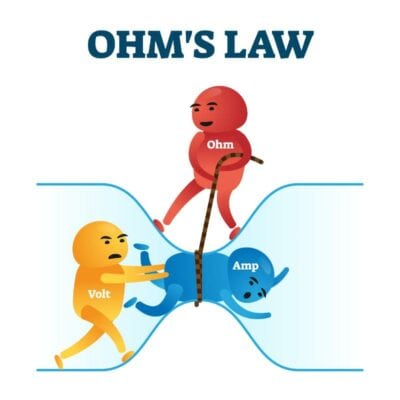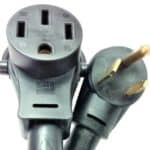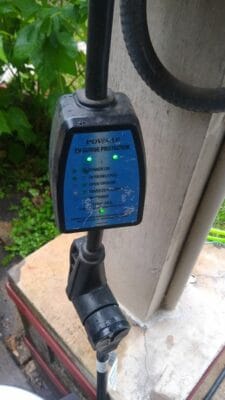Electrical grounding is a concept that gives most of us as much trouble as rubbing our stomachs and patting our heads at the same time. It’s abstract and confusing.
This article will keep things somewhat simple (with one exception) – for two reasons.
- You don’t need to understand Lenz’s Law and Faraday’s Law to grok the basics of grounding. You might need to stretch your brain, but no math is required.
- I am NOT an electrical engineer or licensed electrician. I have a B.S. in Mechanical Engineering and professional experience with AC and DC power distribution circuits, but I’m no industrial electronics expert. So for both of our sakes, we’ll keep things simple and safe.
RV Electrical 101
Voltage, as you know, is akin to electrical pressure. Just like water pressure, voltage “wants” to drive electric current from areas of high potential to areas of low potential. The earth is a convenient “zero point,” so we typically define electrical potential relative to the earth, with terra firma itself as “0 volts.”

Circuits, as you also know, require a complete circular path for electrons to jump and for current to flow. (Mnenomic: electrons are always trying to go home). In the single-phase, 60-Hz, 120-volt alternating current we use inside RVs in North America, that means all AC circuits have a Hot and a Neutral wire going to and from each load. Minimum number of wires: 2.
Now that you’re so armed … let’s dive in.
Why Do We Ground RVs?
We ground circuits as a safety shield. Grounding is NOT necessary for a 120VAC circuit to work properly. Grounding keeps us, the humans, safe.
Let’s go back to our water pressure analogy. What happens if you pour water on a flat table? It doesn’t move. What happens if you pour water down the sink? It drains quickly because it’s moving from a height of high potential energy (due to gravity) to low potential energy. The steeper the slope, the faster the water moves.

Electricity works the same way. The lower the resistance, the more easily current will flow through a conductor. Keep that fact in mind, because that’s the whole reason we ground things.
You, as a human being wrapped in skin, have a certain amount of electrical resistance – and it’s literally skin-deep. Your resistance actually varies widely depending on your skin thickness, fat content, moisture level, sweat salinity, etc. (That’s why a 9V battery shocks your wet tongue but not your dry finger). But a bunch of smart people have already figured that out, so we know that somewhere around 30-48 volts is where electricity starts to become noticeable and potentially dangerous for most people in most situations – although lower voltages can still be dangerous!
So … the whole trick to grounding things is to make the grounding conductor less resistive than you are (preferably a whole lot less). The grounding conductor becomes the steep slope; all (or close to all) of the electricity drains down the grounding wire, and you don’t get shocked and die.
Now, grounding is a lot more complicated than I’ve made it out to be. We also ground to prevent electromagnetic interference, dissipate lightning strikes, and eliminate stray voltages. But that’s for an electrical engineer to explain, not me.
Where Is an RV Grounded?

RV electrical systems are governed by code, in particular Article 551 of the National Electric Code (NEC). In an RV, the entire frame and chassis must be grounded, and all of your electrical components must be bonded (i.e., electrically connected) to the chassis, called a chassis ground.
So how is your camper grounded? It’s simple: Your RV is grounded through your shore power cord. That’s it! The shore power feeder cable connects to your Hot, Neutral, and Ground buss bars, and the ground bar is bonded to the chassis. That’s all she wrote. It’s literally plug n’ play.
When you plug into a power pedestal, it should form an unbroken, continuous, grounded path between the campground service panel (and the Neutral-Ground main jumper*), the campground power distribution system, power pedestal, shore power cord, RV, and your toddler with his finger in the outlet. The unbroken ground path ensures that a “hot-skin” voltage doesn’t show up on your metal parts, such as your door handle.
That means you should always double-check your shore power condition AND the wiring of the receptacle you’re plugging into! If one breaks, stray voltages can develop on your RV’s metal parts.
RV generators have their own rules, which are beyond the scope of this article. Most of the time, if you’re powering a single RV from a single onboard or portable generator, no separate grounding rod is required.
>>> READ MORE: What Size Generator Do I Need for My RV? (A Math-Free Solution)
*ALERT! Note that there should be NO bond between the Neutral and Ground bus bars in an RV distribution panel or at the campground power pedestal! There can only be one Neutral-Ground connection per the NEC, and it ONLY happens at the main service panel.
But … What About Lightning?
There are a lot of misconceptions about RV grounding and lightning. One urban myth is that your tires electrically insulate your RV from lightning strikes. Another is that your leveling jacks are what ground your RV.
First of all, your RV isn’t a Faraday Cage like your automobile. It’s mostly wood and Styrofoam, not metal, so if lightning directly strikes your RV, it’ll probably combust like a popped pimple immediately. Secondly, yes, tires insulate at normal line voltages, but not at the millions of volts of a lightning strike. Electricity will easily pass through once an insulator has exceeded its dielectric strength.
Lastly, your jack pads coming in contact with the earth is not an Effective Ground-Fault Current Path. There’s way too much contact and soil resistance. Never rely on your leveling jacks to “ground” your RV if there’s something wrong with your power hookup! Your GFCI outlet, designed to protect you from getting shocked and dying, will probably NOT trip with a simple “jack pad ground.”
When A Ground Isn’t … a Ground
FAIR WARNING: I said this article was somewhat simple with one exception – and this next section is it. Feel free to skip to the last section.

Somewhat confusingly, in our regular speech, we’ve all gotten in the bad habit of using the word “ground” to refer to multiple, distinct things. We should all abide by the terminology in Article 250 of the NEC. I’m working on it myself!
In simple low-voltage DC systems, we sometimes say “ground” to refer to a circuit return path. This is really a “common ground” or “power ground” – although maybe saying the “negative” wire is more straightforward. Although yes, the negative wires are usually bonded to the chassis ground. (Head spinning yet?)
When a DIYer says “ground,” he/she may be referring to an Equipment Grounding Conductor (EGC) or Grounding Electrode (GE). These “grounds” serve different purposes!
Equipment Grounding Conductor
An example of an EGC is the bare copper wire in Romex that we all know and love. The job of the EGC is to “carry electrical fault-current back to the distribution panel (source) any time a short-to-ground event occurs.” Normally, it should carry no current. Remember, electricity is always trying to return to its source; an EGC defines the fault current return path. When paired with the Neutral-Ground bond, it allows GFCI outlets to do their job and trip before your heart goes into fibrillation.
Grounding Electrode
An example of a GE is a fat 8-ft copper rod hammered into the ground with a cable attached to it. The GE is where the EGC gets connected to the earth. A copper rod is an example of an earth ground electrode, commonly used where the neutral leg is electrically bonded to the earth (0 volts, remember?) to prevent voltage gradients from forming. This forms an equipotential bonding plane, where everything not “Hot” is kept around 0-3 volts. If those parts were not grounded, they would be “floating,” and unwanted and potentially dangerous voltages could develop. A GEC also provides a direct-to-eath connection for high-voltage surges and spikes from lightning strikes.
What About Grounding Generators?

Grounding generators is a whole other can of worms. When a portable generator with a bonded neutral is powering a single RV, Mike Sokol says that no separate earth ground is required because you’ve established an isolated local grounding plane. This is in line with OSHA and the requirements based on the NEC Article 445 section on generators and the requirements of a Separately Derived System.
Sometimes, an electrician’s advice will conflict with your Owner’s Manual. Champion recommends grounding all its generators as a general safety practice. Generac, meanwhile, says that an 8-ft earthing rod is usually required when you’re powering an RV – but not if you’re just using an electrical extension cord. And just because I found this article so helpful, if you want to really dive deep down, read what Guy Holt has to say!
Not gonna lie – I start mumbling when I try to explain these concepts in conversation. I’m constantly refreshing and refining my understanding of ground loops and floating neutrals, so I’ll stop here before I get myself into trouble!
Super Simple Takeaways about Grounding Your RV

If your head hurts, stop reading this article and take some Ibuprofen. Let’s wrap up with 5 super-simple takeaways about grounding your RV and staying safe:
- Use an EMS surge protector every time you plug in to protect your RV’s electrical system from bad campground grounds and bootleg wiring. (>>> READ MORE HERE!)
- Keep your shore power cord in good condition to make sure there’s an unbroken, reliable ground connection.
- If you feel a tingle when you touch any part of your RV, that’s a hot skin, and it’s a symptom of a bad ground and fault currents. Get it fixed immediately!
- Generally, no, you don’t need to earth-ground a portable RV generator. You might need a simple “generator neutral bond plug,” though. But always read your Owner’s Manual!
- No, you don’t need to carry around an 8-ft copper earthing rod to ground your RV. In fact, if you use an EMS to plug in and don’t use a generator, you can usually forget about the whole idea of grounding at all! Doesn’t that sound nice?
REFERENCES
Pierce, Rod. “Electricity Water Analogy” Math Is Fun. Ed. Rod Pierce. 27 Nov 2023. 19 Dec 2023 http://www.mathsisfun.com/physics/electricity-water-analogy.html
Leave a Reply